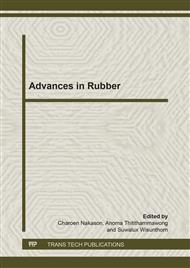p.251
p.255
p.259
p.263
p.267
p.272
p.276
p.280
p.285
Comparison of Thermal Stability of Sulfur, Peroxide and EB Irradiation Cured NR Compounds Containing Ground EPDM Waste
Abstract:
This article described concerning to the effect of sulfur, peroxide and electron beam irradiation cured on the thermal stability of natural rubber compounds containing ground EPDM waste. Semi-efficient vulcanization (semi-EV), dicumyl peroxide (DCP) and the EB irradiation at 200 kGy were used and applied in the compounds. Thermal analysis namely thermogravimettric analysis (TGA) and its kinetics of degradation process were investigated. Results indicated that the EB irradiation revealed superior thermal stability by shifting the decomposition temperature at various weight loss and maximum derivatives followed by peroxide and sulfur vulcanizing systems. The activation energies of degradation of the vulcanizates were determined by applying the Coats-Redferns method. It can be verified that the activation energies observed in the vulcanizates were in good agreement with the thermogram results. The highest thermal stability obtained from EB irradiation might be due irradiation-induced-crosslinking resulting to more thermal energy is supplied to overcome the apparent activation energy of the vulcanizates.
Info:
Periodical:
Pages:
267-271
Citation:
Online since:
November 2013
Authors:
Keywords:
Price:
Сopyright:
© 2014 Trans Tech Publications Ltd. All Rights Reserved
Share:
Citation:


